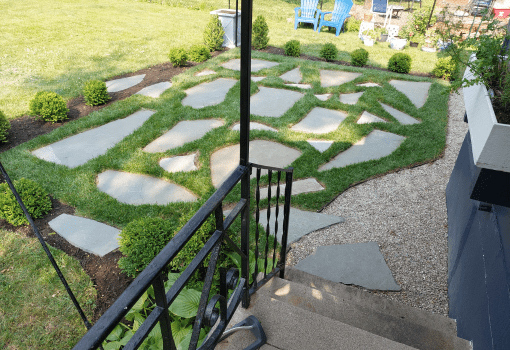Natural Hardscapes
Incorporating natural hardscapes into property plans offers numerous advantages, aligning with principles of sustainability, self-reliance, and enhancing both the aesthetic and functional aspects of outdoor spaces. Here, we explore the benefits of integrating natural hardscapes, focusing on their environmental, practical, and aesthetic contributions:
1. Environmental Benefits
-
- Water Conservation: Natural hardscapes, such as permeable paving and rain gardens, help manage stormwater runoff. By allowing water to infiltrate the soil, they reduce the need for irrigation and help replenish groundwater supplies.
- Wildlife Habitat: Incorporating natural elements like rock formations, boulders, and native plants creates habitat and food sources for local wildlife, promoting biodiversity.
- Carbon Sequestration: By incorporating organic materials and promoting plant growth, natural hardscapes can help sequester carbon, mitigating the impacts of climate change.
- Air Quality: Plants in hardscapes help improve air quality by absorbing pollutants and releasing oxygen.
2. Practical Benefits
-
- Durability: Natural materials like stone, wood, and metal require minimal maintenance and can last for decades, making them a cost-effective and durable choice for hardscapes.
- Functionality: Natural hardscapes can serve multiple purposes, such as seating areas, pathways, retaining walls, and outdoor kitchens or dining spaces.
- Accessibility: Incorporating natural hardscapes can improve accessibility, with features like ramps, stepping stones, and smooth, stable surfaces.
- Low Maintenance: Natural hardscapes typically require less upkeep than traditional landscaping, saving time and resources.
3. Aesthetic Benefits
-
- Curb Appeal: Natural hardscapes enhance the overall appearance of a property, improving curb appeal and potential resale value.
- Inviting Spaces: Incorporating natural elements creates warm, inviting outdoor spaces that encourage relaxation and socializing.
- Uniqueness: Natural hardscapes offer a wide range of materials and designs, allowing for personalized and unique outdoor spaces.
4. Health and Wellness Benefits
-
- Stress Reduction: Interacting with natural elements, such as plants and stone, has been shown to reduce stress, improve mood, and promote relaxation.
- Physical Activity: Incorporating natural hardscapes can encourage physical activity, with features like garden paths, outdoor exercise areas, or rock-climbing walls.
Action Steps and Recommendations
1. Assess your property’s unique features, such as topography, sunlight, and existing vegetation, to determine the best natural hardscape elements.
2. Incorporate a mix of materials, such as stone, wood, metal, and organic elements like moss or succulents, to create a cohesive and inviting space.
3. Consider the functionality of your outdoor space, and design hardscapes that support your intended use, such as seating areas, pathways, or outdoor kitchens.


